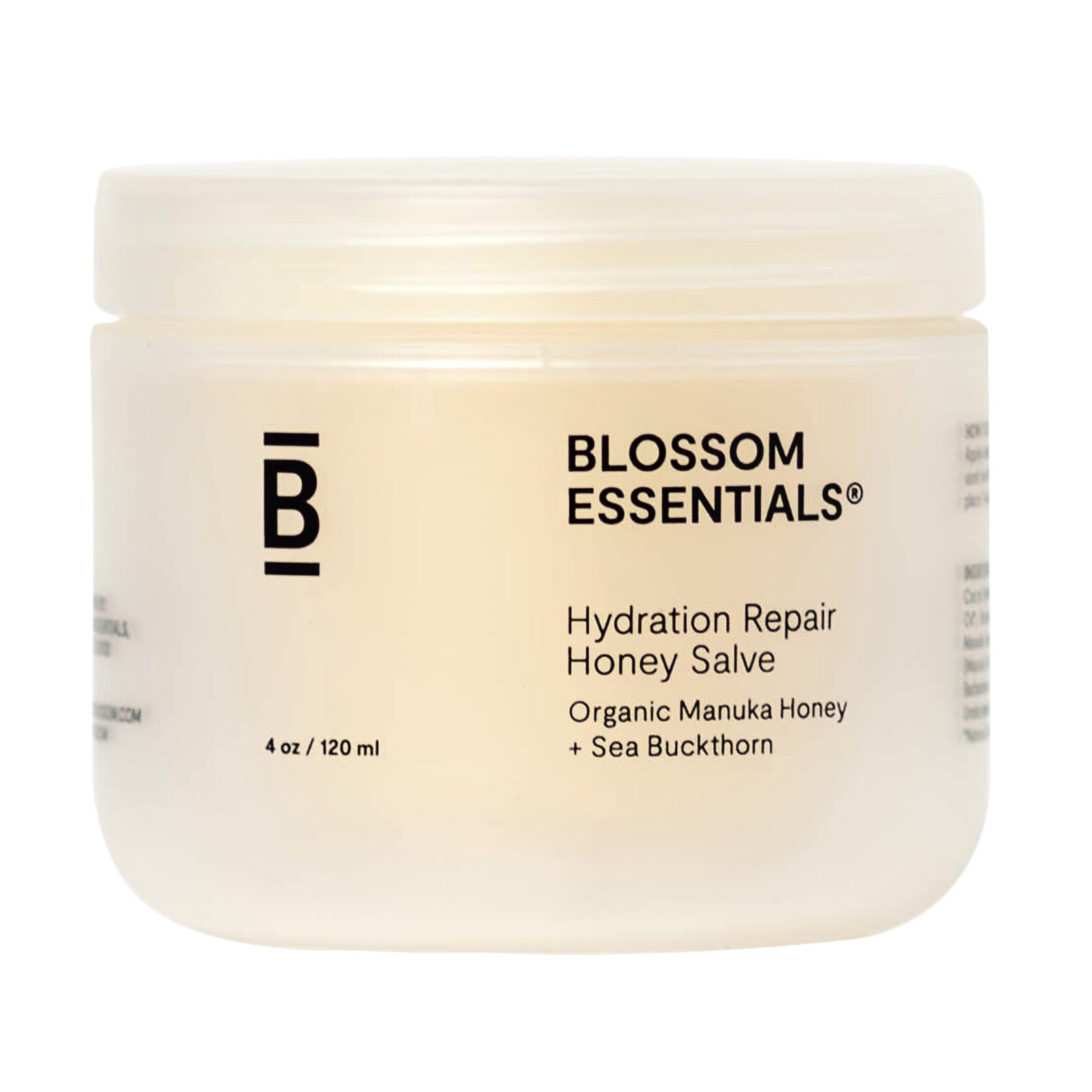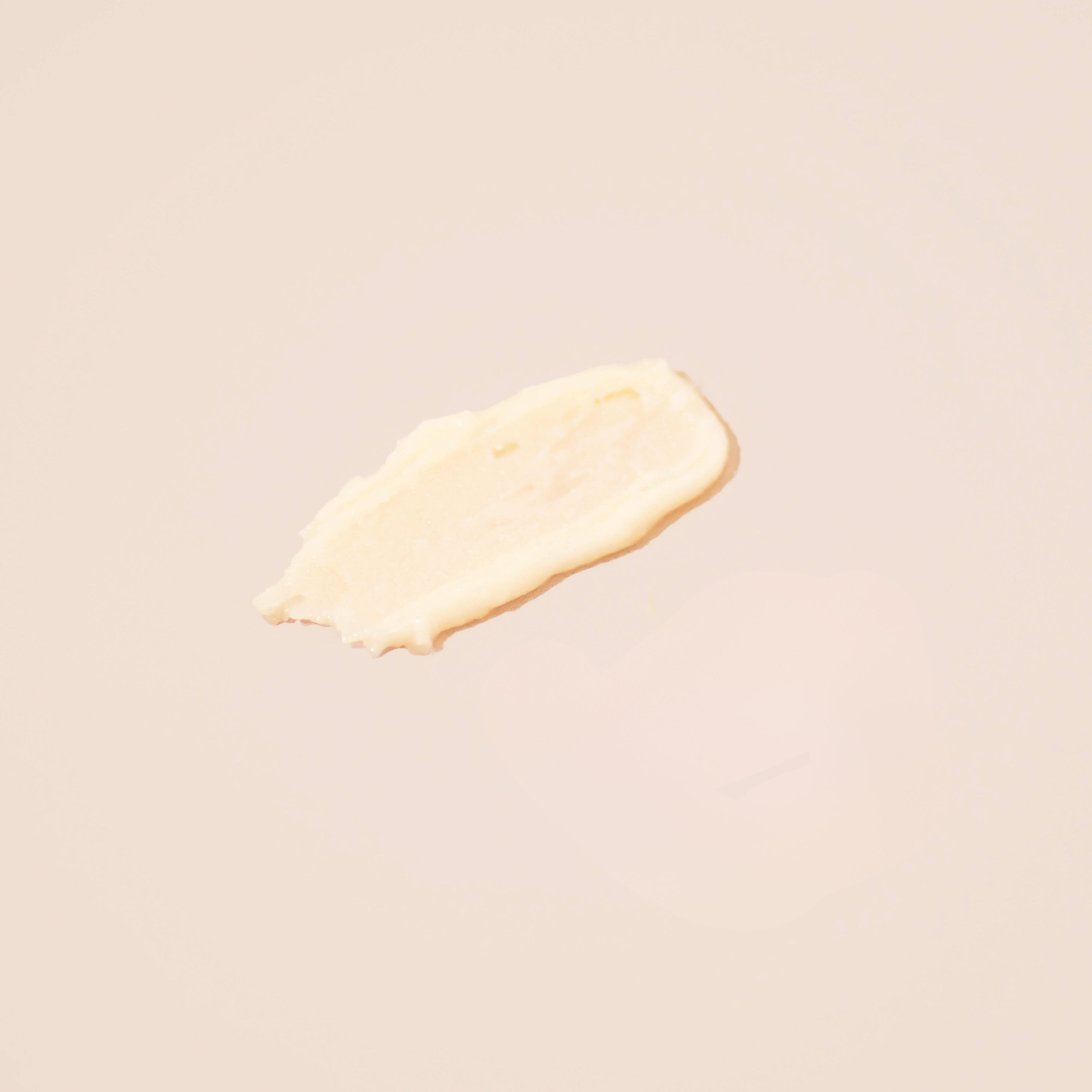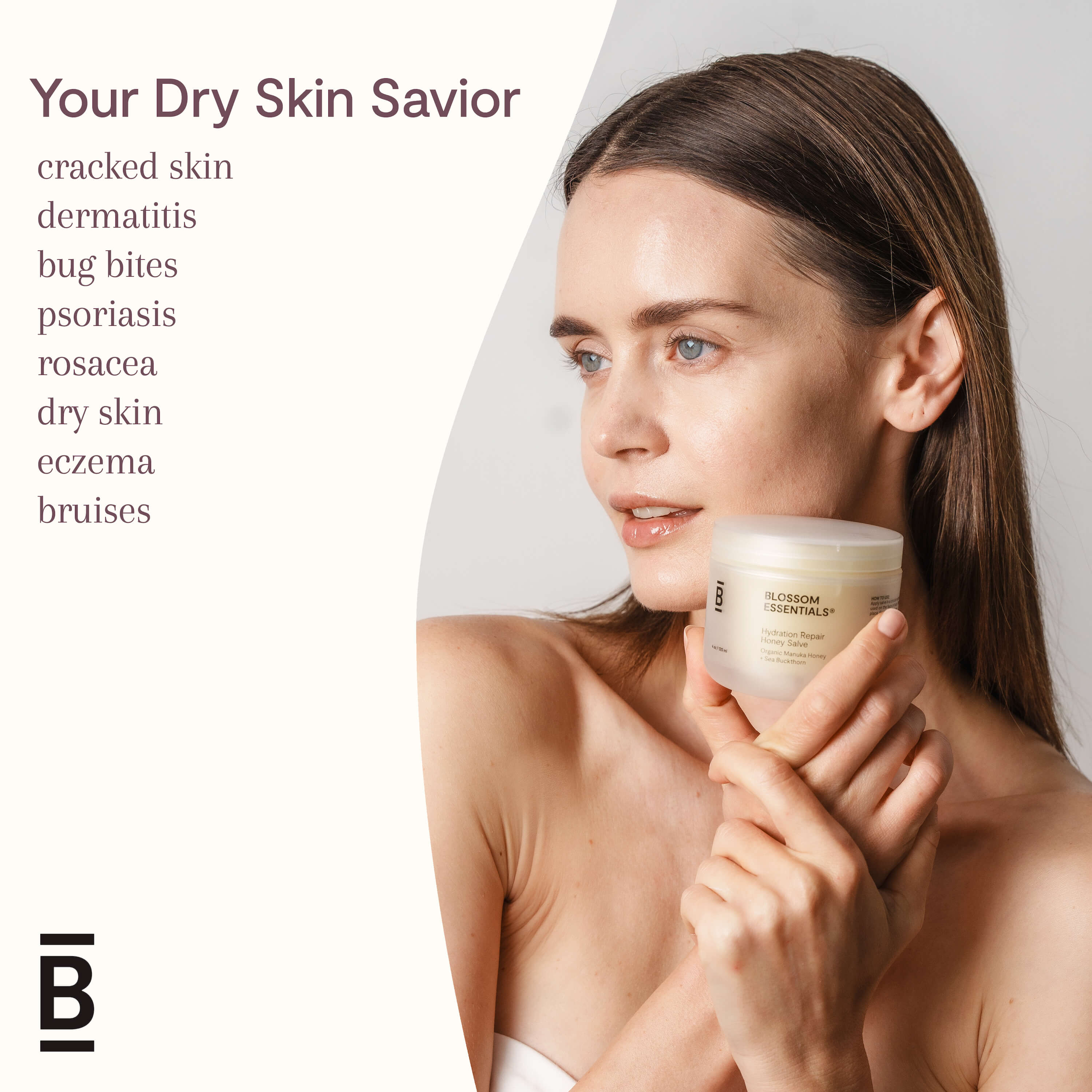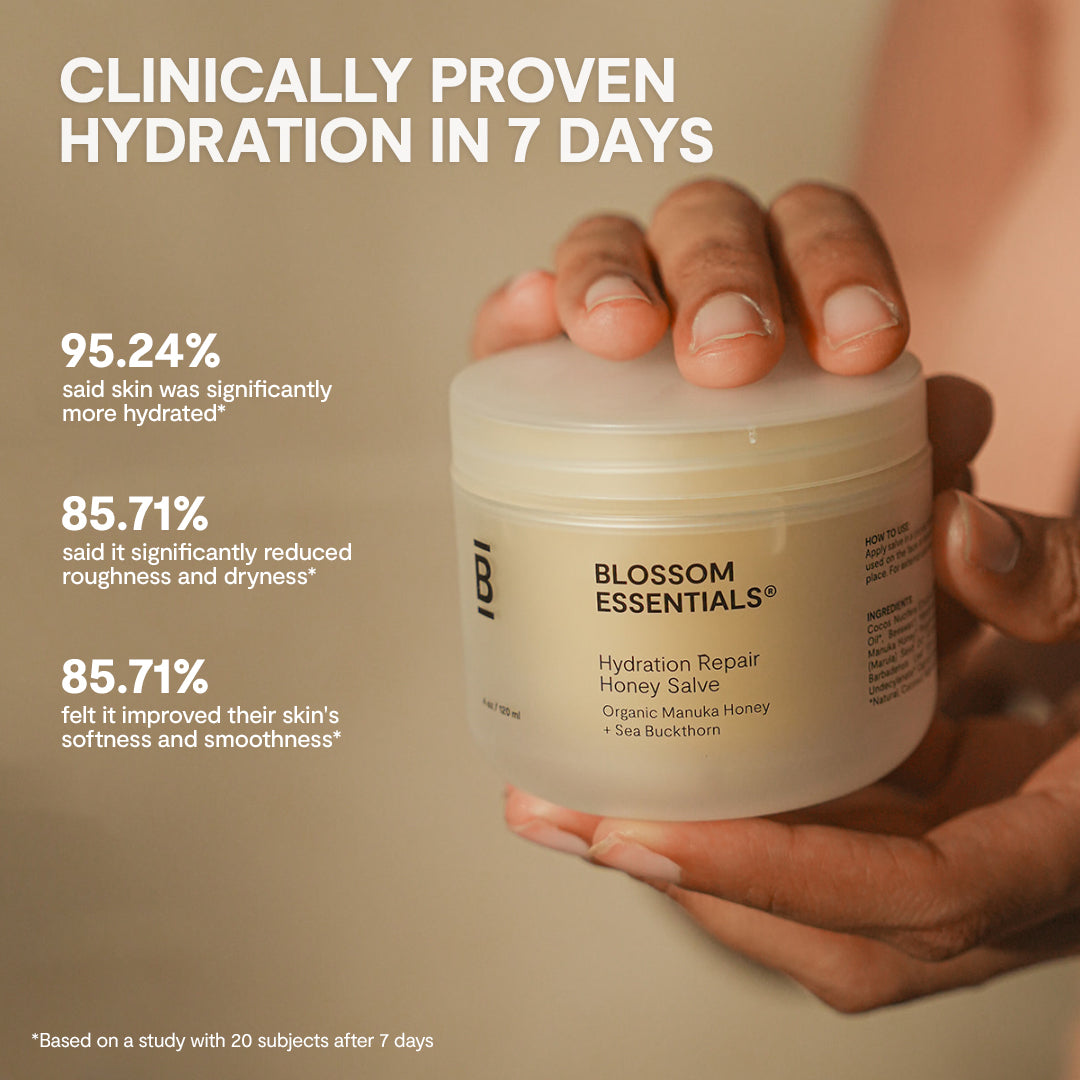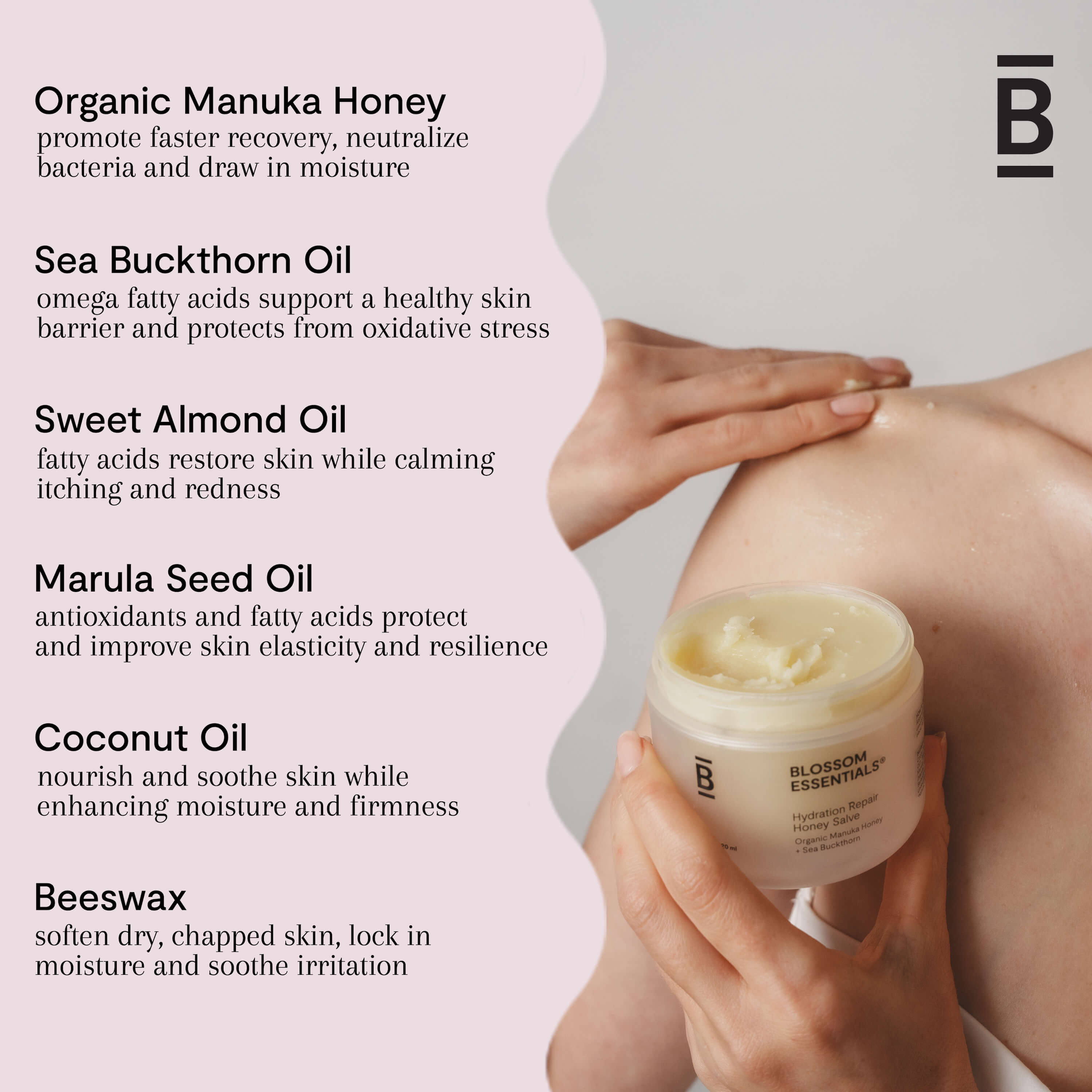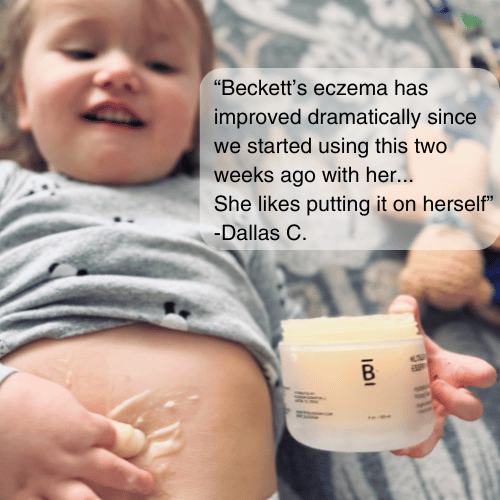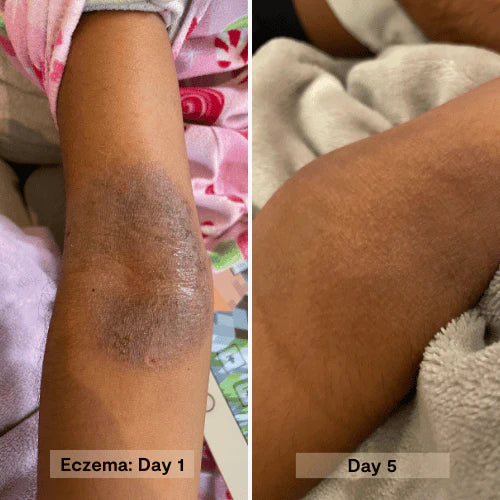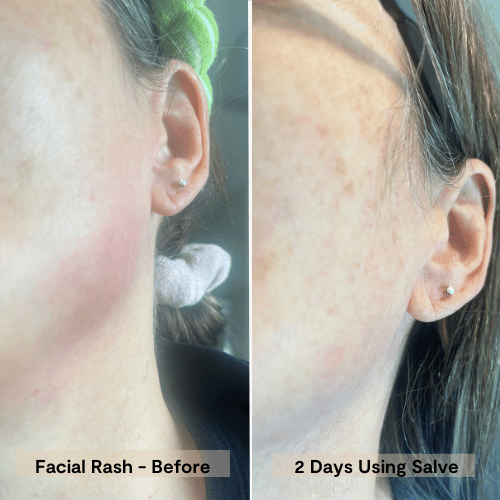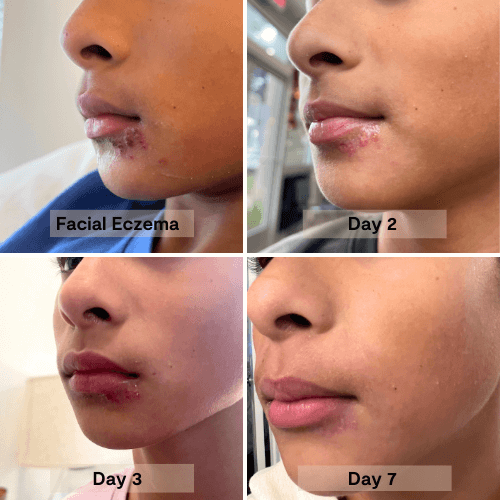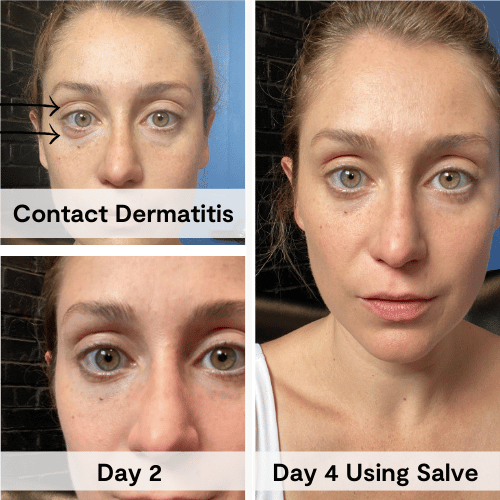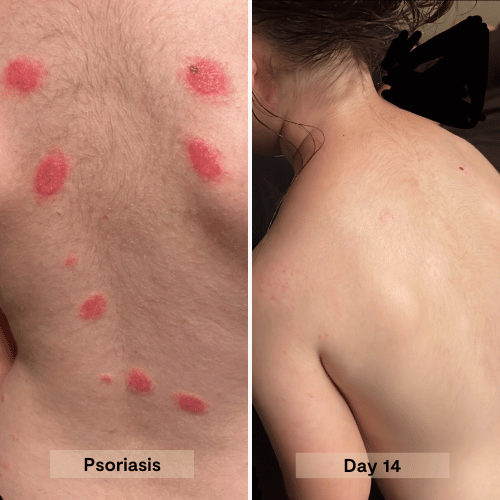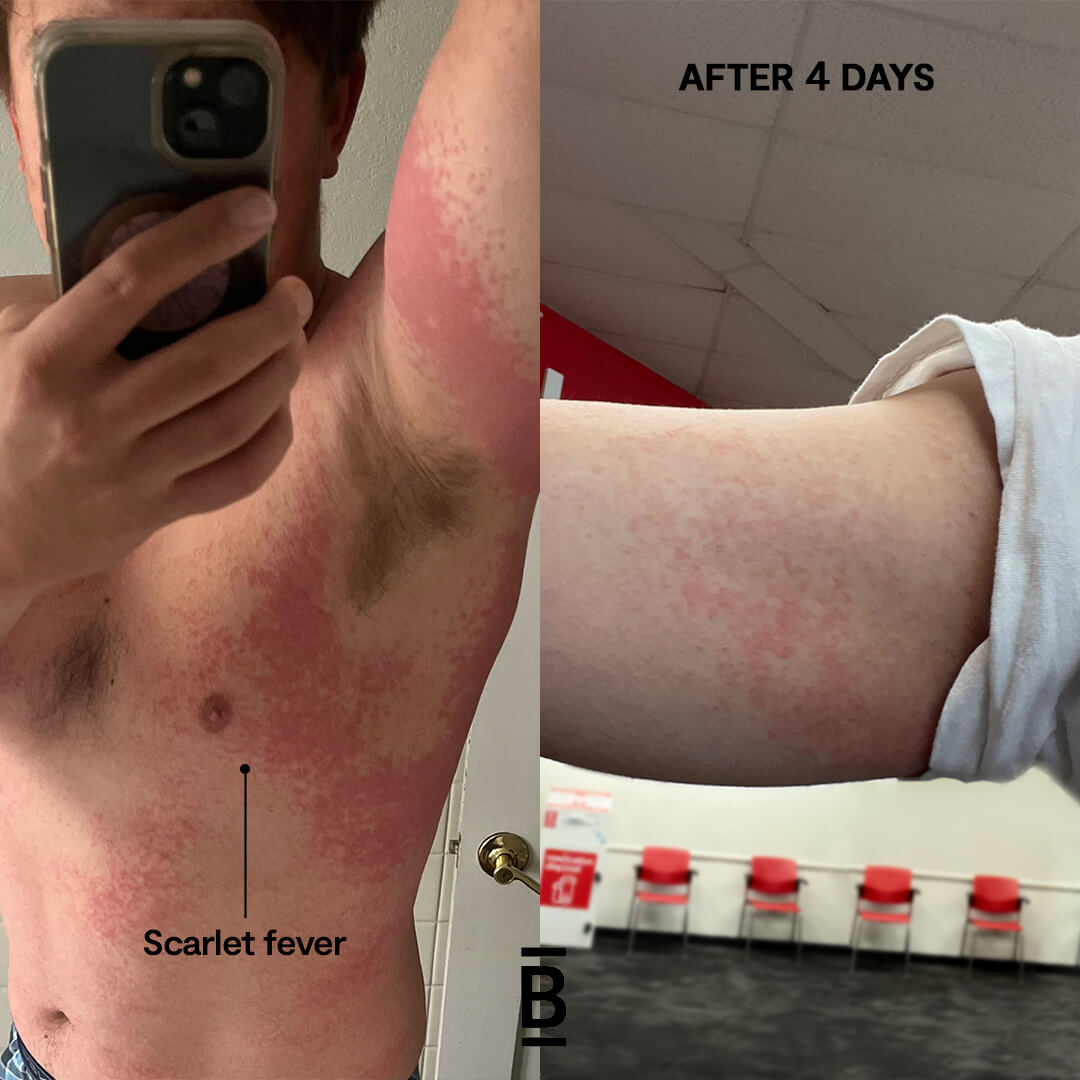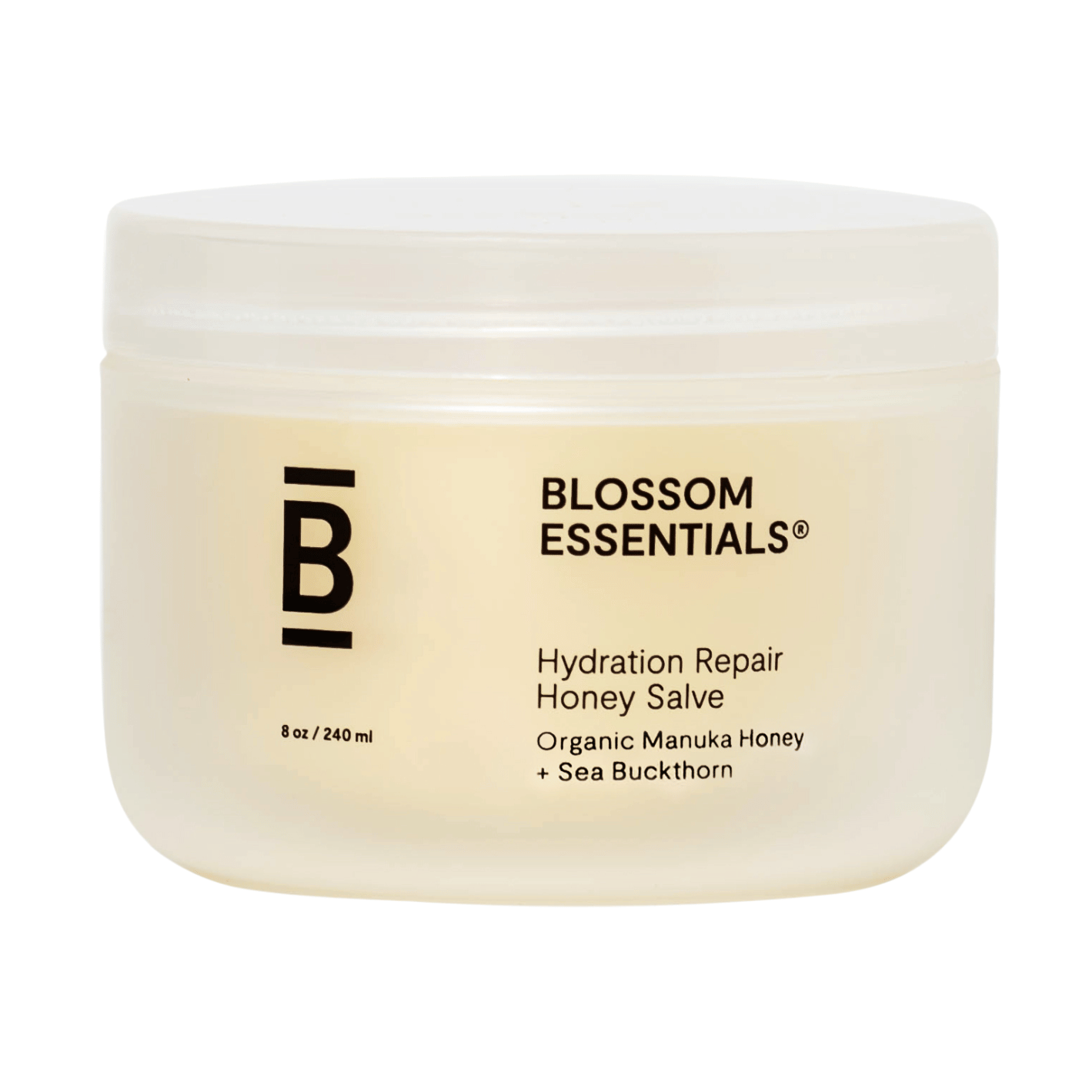A potent blend of organic Manuka honey, nourishing oils, and natural moisturizers penetrates deeply to intensely hydrate, relieve dryness, and repair the skin barrier. This salve quickly soothes damaged, itchy skin, leaving it rejuvenated, healthy, and wonderfully soft.
Navigating Common Skin Concerns
DEMYSTIFYING ROSACEA
Ever noticed a persistent flush across your cheeks that just won’t quit, no matter how calm you feel? You might be experiencing rosacea, a common but often misunderstood skin condition affecting millions. Here, we’ll unravel the mysteries of rosacea and discuss how to keep your skin calm, comfortable, and radiant.
THE ROSACEA RUNDOWN
Rosacea (pronounced roh-ZAY-sha) is like that uninvited guest who won’t take the hint and decides to overstay their welcome. It’s a chronic inflammatory skin condition that primarily affects the face, causing redness, visible blood vessels, and sometimes small, red, acne-like bumps. It’s as if your skin’s constantly on high alert, even when there’s no real threat. Believe it or not, rosacea has been documented throughout history, although it wasn’t always called by its current name, and although it was first medically described in the 14th century, but it wasn’t until the 19th century that dermatologists began to distinguish it from acne and other skin conditions.
If you have rosacea, you’re certainly not alone! It’s estimated that rosacea affects 415 million people worldwide (with 16 million in the US alone!). Although it’s most common among fair-skinned individuals, particularly those of Northern European descent, rosacea can affect people of all skin tones – it’s just often underdiagnosed in darker skin because the redness may be less visible. It isn’t a one-size-fits-all condition, either, having four main types: Erythematotelangiectatic Rosacea (that permanent blush), Papulopustular Rosacea (bringing pimples to the party), Phymatous Rosacea (a rare type causing thickened skin), and Ocular Rosacea (affecting the eyes).

THE ROSACEA RIDDLE: CAUSES AND SYMPTOMS
Rosacea remains something of a dermatological mystery, but scientists generally believe it stems from a perfect storm of factors: faulty blood vessel regulation creating traffic jams that cause redness, an overabundance of microscopic mite roommates (Demodex folliculorum), genetic factors (thanks, family tree!), and an overzealous immune system acting like an aggressive bouncer when there's no real threat. These factors manifest as the telltale signs we've all come to recognize: persistent redness that looks like a permanent blush across your cheeks and nose, visible blood vessels playing connect-the-dots on your skin, acne-like bumps without the blackheads, and that frustrating burning or stinging sensation that makes even water feel like your enemy.
What makes rosacea particularly tricky is its long list of potential triggers, all seemingly waiting to ambush your skin at the most inconvenient moments. Think of these triggers as rosacea's favorite party guests: spicy foods and alcohol (especially that glass of red wine you were looking forward to), temperature extremes that swing your skin from winter windowpane to summer sidewalk, UV rays and harsh winds tag-teaming against your complexion, emotional stress turning up the heat, and skincare products that promised to help but instead betrayed you with irritating ingredients. The challenge lies in identifying your personal triggers – what sends one person's skin into a flaring frenzy might leave another's completely unfazed. This unpredictability is what makes rosacea not just a skin condition but a daily puzzle that requires patience, observation, and a touch of detective work to solve.

ROSACEA SOLUTIONS
We know it’s frustrating to see that redness staring back at you in the mirror, but while we're about to explore various treatment paths, it’s important to remember that your first stop should always be a dermatologist's office. No online article (even our carefully crafted one!) can replace professional medical advice tailored specifically to your unique skin situation. With that crucial disclaimer noted, let's explore some of your potential options:
1. PRESCRIPTION PATHWAYS
When rosacea decides to really make itself known, prescription treatments might be necessary. Here’s what your dermatologist might recommend:
- Topical Medications:
- Metronidazole: This antibiotic cream or gel reduces inflammation and redness.
- Azelaic Acid: Helps manage bumps, lesions, and swelling.
- Ivermectin: Targets those microscopic mites we mentioned earlier.
- Brimonidine and Oxymetazoline: These work like traffic controllers for your blood vessels, temporarily reducing redness.
- Oral Antibiotics: For moderate to severe rosacea, oral antibiotics like doxycycline may be prescribed, usually at a lower dose than what’s used for bacterial infections.
- Isotretinoin: In severe cases that don’t respond to other treatments, this powerful acne drug might be used (though it’s not FDA-approved specifically for rosacea).
- Laser and Light Therapy: These treatments can target visible blood vessels and reduce persistent redness. Think of them as hitting the reset button on your skin’s appearance.
2. OVER-THE-COUNTER ALLIES
Not ready for prescription options? Several over-the-counter products can help manage mild rosacea:
- Gentle Cleansers: Look for sulfate-free, non-foaming cleansers that won’t strip your skin barrier.
- Barrier-Repairing Moisturizers: Products with ceramides, niacinamide, and hyaluronic acid can strengthen your skin’s natural defenses.
- Mineral Sunscreens: Zinc oxide or titanium dioxide-based sunscreens with SPF 30+ are less likely to irritate rosacea-prone skin.
- Green-Tinted Primers and Concealers: These cosmetic products can help neutralize redness for an even skin tone.
- Micellar Water: A gentle way to remove makeup without irritating sensitive, rosacea-prone skin.
3. NATURAL APPROACHES
For those preferring a more natural approach, several options may help calm rosacea’s fire:
- Aloe Vera: This cooling plant extract can help soothe inflammation and redness.
- Green Tea: Applied topically or consumed as a beverage, green tea’s anti-inflammatory properties may help calm rosacea flares.
- Oatmeal: Colloidal oatmeal in baths or masks can reduce irritation and protect the skin barrier.
- Licorice Extract: Contains compounds that may help reduce redness and inflammation.
- Chamomile: Has anti-inflammatory properties that can soothe irritated skin (though be cautious, as some people may be allergic).
- Omega-3 Fatty Acids: Found in fatty fish, flaxseeds, and walnuts, these may help reduce inflammatory responses in the body.
- Honey: Particularly Manuka honey, which has antimicrobial and anti-inflammatory properties.

YOUR ROSACEA-FRIENDLY SKINCARE ROUTINE
Creating a skincare routine when you have rosacea is like walking a tightrope – it requires balance, caution, and the right tools. Here’s a simple yet effective routine to keep your skin happy:
Morning Routine
- Cleanse Gently: Start your day with your gentlest cleanser, ideally one formulated without harsh sulfates or fragrances. Use lukewarm (never hot!) water and pat – don’t rub – your face dry with a soft towel.
- Soothe and Calm: Apply our Hydration Repair Honey Salve, packed with Manuka honey to help reduce redness and strengthen your skin barrier.
- Moisturize: Lock in hydration with a good quality hydration oil. Look for ones that are specifically designed for sensitive, reactive skin, perhaps with ceramides and squalane.
- Protect: The most crucial step! Apply a generous amount of a high SPF (at least 50) suncream, conduct patch tests with a few brands until you find one you know won’t exacerbate irritation.
Evening Routine
- Remove Makeup: If you wear makeup, start with our Hydration Boost Face Cleanser, which will dissolve makeup and sunscreen without the need for energetic scrubbing.
- Treat: If you’ve been prescribed any skin medication, now might be the best time to use it. Always consult with your dermatologist before combining medication with over-the-counter products, though!
- Moisturize: Seal everything in with our Hydration Recovery Face Cream, which creates a protective barrier while you sleep.
Weekly Treatments
- Mask: Once a week, treat your skin to a non-abrasive mask that will soothe inflammation and provide intense hydration.
- Facial Mist: Try keeping a thermal water spray in your bag for on-the-go calming. A quick mist can help reduce flare-ups triggered by environmental stressors.
MYTH BUSTING: SEPARATING ROSACEA FACTS FROM FICTION
Despite all the mystery surrounding the exact causes of rosacea, there are a few myths out there about the condition that we can clear up right away:
While they may look similar, rosacea and acne are different conditions with different causes and treatments. Using acne products on rosacea can actually make it worse!
Rosacea has nothing to do with how clean your face is. In fact, over-cleansing can irritate rosacea and make it worse.
While it’s more commonly diagnosed in fair skin, rosacea affects people of all skin tones. It’s just often overlooked or misdiagnosed in darker skin types.
You can’t “catch” rosacea from someone else. It’s not an infection; it’s a chronic inflammatory condition.
Rosacea is a chronic condition that requires ongoing management. While symptoms may come and go, they typically worsen over time without treatment.
The right makeup, especially mineral-based products designed for sensitive skin, can help conceal redness without aggravating your condition.

THRIVING THROUGH ROSACEA
Living with rosacea goes beyond just treating the physical symptoms – it’s about embracing self-acceptance and developing strategies to navigate life confidently. Here’s how to thrive with this condition:
- Find Support: Connect with others who understand through online communities or support groups.
- Practice Self-Compassion: Treat yourself with the kindness you would offer a friend.
- Keep a Trigger Journal: Track what sets off your flares to better avoid these triggers.
- Be Weather-Wise: Protect your face in extreme temperatures with scarves in winter and wide-brimmed hats in summer.
- Focus Outward: Remember that others are usually more focused on themselves than on analyzing your appearance.
- Workplace Accommodations: If office environments trigger your rosacea (like overheated rooms), don’t hesitate to discuss reasonable adjustments.
Your rosacea journey isn't one you have to walk alone. On those days when your skin feels like it's betraying you, take a deep breath and remind yourself that you're managing a medical condition, not a personal flaw. With the right treatments, thoughtful lifestyle adjustments, and a compassionate self-care approach, you can absolutely thrive beyond the redness. Your skin story is just one chapter of who you are – not the whole book.

Frequently Asked Questions
While rosacea typically begins after age 30, it can occasionally affect children. If your child shows persistent facial redness or bumps, consult a pediatric dermatologist rather than assuming it’s acne or sensitivity.
Currently, there’s no permanent cure for rosacea, but with proper treatment and lifestyle management, symptoms can be effectively controlled. Think of it as a condition to manage rather than eliminate.
Without treatment, rosacea typically progresses over time. Early intervention is key to preventing worsening symptoms and permanent skin changes like thickening.
Absolutely! While rosacea is diagnosed more often in women, men tend to experience more severe symptoms when they do develop it, particularly rhinophyma (enlarged, bumpy nose).
For many people, diet plays a significant role in rosacea flares. Common culprits include spicy foods, hot beverages, alcohol, and foods high in histamine like aged cheeses and fermented products. However, triggers vary widely between individuals.
Some people find relief with supplements like omega-3 fatty acids, zinc, and nicotinamide (a form of vitamin B3). Always consult your healthcare provider before starting any supplement regimen.
Research suggests potential associations between rosacea and other conditions like migraine headaches, certain gastrointestinal disorders, and cardiovascular disease. If you have rosacea, it’s worth discussing these potential connections with your healthcare provider.
Yes! Exercise is important for overall health, but you might need to modify your routine. Choose cooler environments, opt for lower-intensity workouts or shorter intervals, and always keep your face cool with a spray bottle of water.




